Our featured boat for April is the Essex smack ‘Transcur’, CK365, built in 1889 by Aldous & Sons. Pete Thomas provides the story of her restoration in several instalments, the first entitled ‘We wanted an Essex Smack!’ The cover photo by Beverley Yates shows ‘Transcur’ racing at Southwold with the OGA, 2024.
We had sailed our old Poole smack ‘Margaret Catchpole’ for many happy years from the Orwell estuary, going on trips to the Netherlands and cruising along the Suffolk and Essex coast. ‘Margaret Catchpole’ may sound like a local boat but the ‘Catchpole’ was added when she was brought to the Orwell from Chichester. My parents remember her coming to the Orwell Yacht Club in 1952, she was last there in 2004. We always liked the East Coast working boats and I originally looked at ‘Merlin’ in 1982 when she was at St Oyths Boatyard, sitting on the quay with her old Austin 7 engine. She was in a poor state and I decided she was too much work for me. ‘Margaret Catchpole’ came along and ‘Merlin’ was forgotten. It was another five years when I saw ‘Merlin’ again, still sitting in the same position on the quay, planks falling off, lead keel gone and oh so much rot. I acquired her for a small sum and together Clare and I restored her to get her sailing again. She was so much fun and had some interesting history.


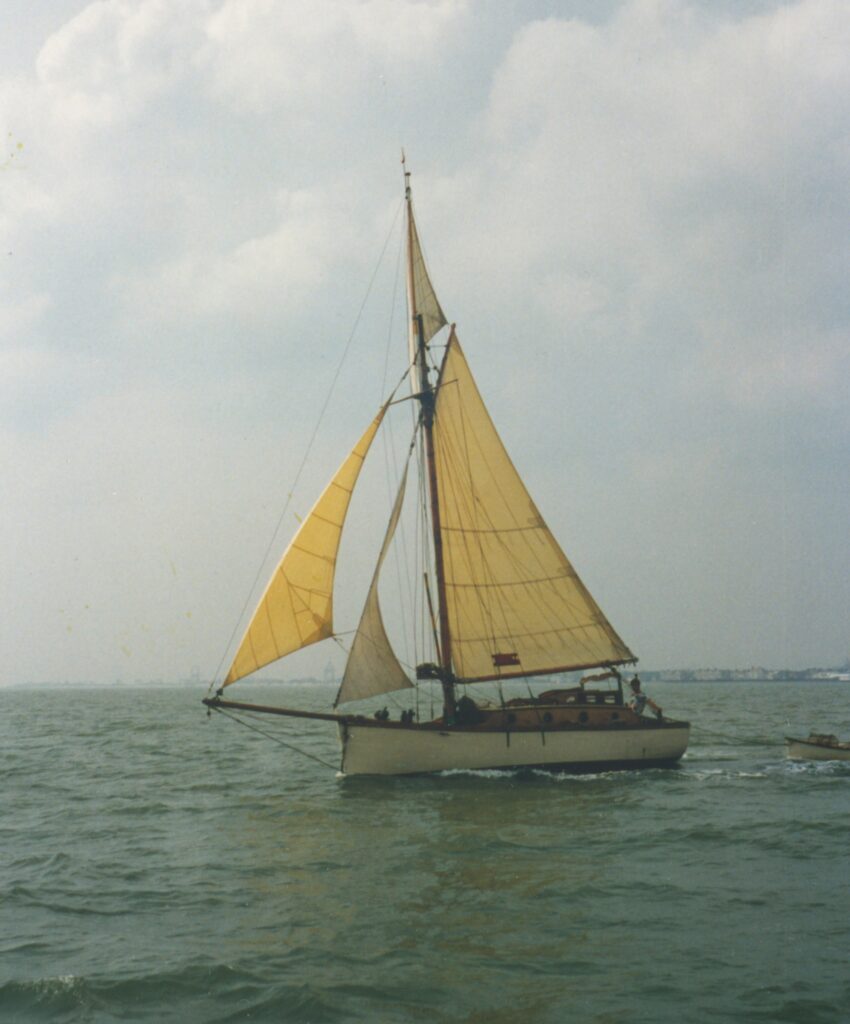
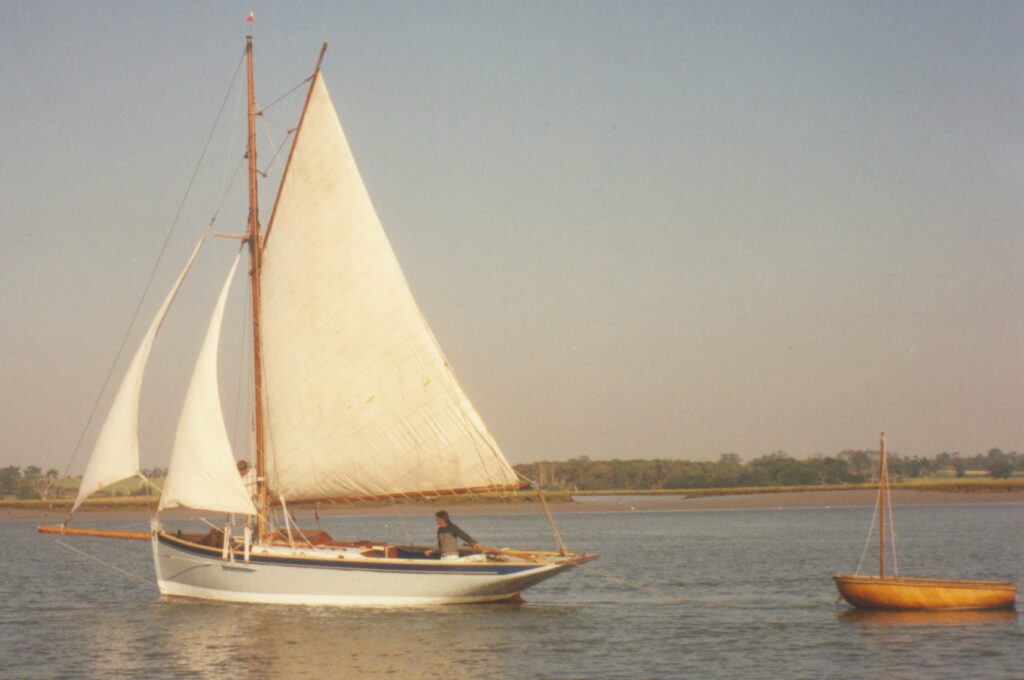
We sailed her and raced her around the Orwell estuary, we wanted to sail with the smacks. She looked just like a little one but with a low coachroof and doghouse. We were not allowed to play with the bigger smacks though. ‘Get a proper smack!’ we were told. In the early 1990s smacks were still to be found lying about in creeks and in need of repair. Rebuilt smacks were just too much work and way beyond our budget. Every year on New Year’s day we would go for a drive to see the old boats, often finishing up at Maldon, Tollesbury or Brightlingsea to see what was about. We had been very keen on ‘Electron’ which had been rebuilt by Dick and Andy Harman, a nice size, 36ft easily managed by two and plenty of room below. She was in good shape having been totally rebuilt, spars, sails and rigging. Unfortunately, she was still just outside our budget, by todays standards a tiny amount. We kept looking. ‘Phantom’ was looked at but again there was likely to be a lot of work to be done soon. We went to Liverpool to look at what was called an Essex smack. We had a wasted journey, it was not a smack. We heard there was a smack in the Netherlands for sale, needing work but the right size. The trip to Haarlem, close to the outskirts of Amsterdam, led me to ‘Maud’. She had been ferro-concreted back in the late 1970s. The timber down below was rotten, some of it just not to be seen, another fruitless journey. I believe she is still afloat in the Netherlands, 23 years later.
It was clear to me that we couldn’t afford a rebuilt smack and that the only way to get one was to find an old one and rebuild it. I remembered reading Terschelling Sands by Frank Mulville where he, his family and friends were going on their summer cruise heading towards the Baltic. They never got there and very nearly lost the smack ‘Transcur’ driving her aground on the ever shifting sands in the area. ‘Transcur’ was Bermudan rigged at that time. I pored over the many magazines we had collected over the years and found an advert for ‘Transcur’ in Classic Boat, 1996. In Practical Boat Owner I found a photo of her with an article about the teredo shipworm, a borer that might attack your boat. I was a little put off. What were the chances of the boat being for sale or even in commission? I phoned the number in Classic Boat. It was a friend who had advertised her for the owner who still had the boat and it may be for sale. Two weeks later it was agreed we would meet the owner and view the boat on the slip at Lymington public quay. When we arrived at the quay the owner was there but the boat was still on a mooring, cover flapping. Not what we’d agreed but we rowed out to the boat and climbed on board. It was all a bit of a shock. There were ply patches in several places on her deck, the stanchions were clearly rotten and it was important to watch what you walked on for fear of making a hole.
That classic mouldy smell oozed out when the hatch was opened, the boat was rotten as a pear. Surprisingly the bilges were quite dry. The engine was not in the boat. Apparently a ‘new’ one had been acquired (turned out to be an ex military tank generator Morris Vedette engine). It seemed that years of neglect had allowed the boat to decompose. The rot in the frames, planking, deck and beamshelf was so extensive that a total rebuild would be necessary. The plus points were that she was the right size and had plenty of room below. However, there were too many negatives. We left thinking we had another wasted journey. Another year passed and we still hadn’t found our Essex smack. We heard there was one at Boal Quay, Kings Lynn. Another day trip out. We found the smack lying against the wall by the carpark, used as mooring staging. She was originally a 40ft plus Wash smack, the ‘Victorious’. By now I was becoming convinced that if we wanted a Essex smack I would have to rebuild one. We had the space at home, I had all the tools, I thought I could I do it.
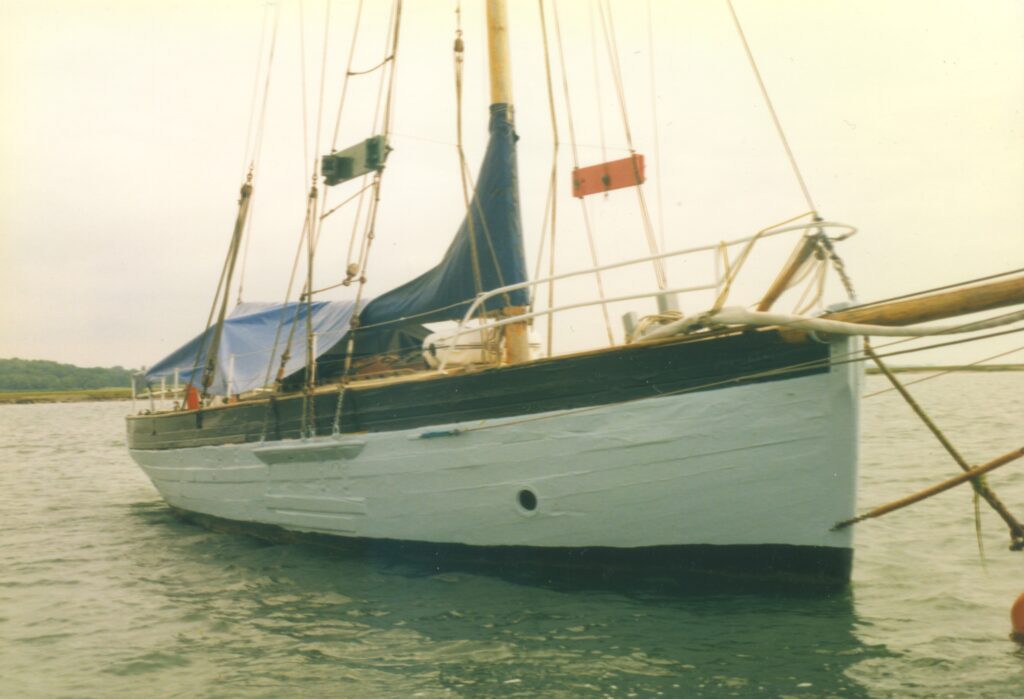
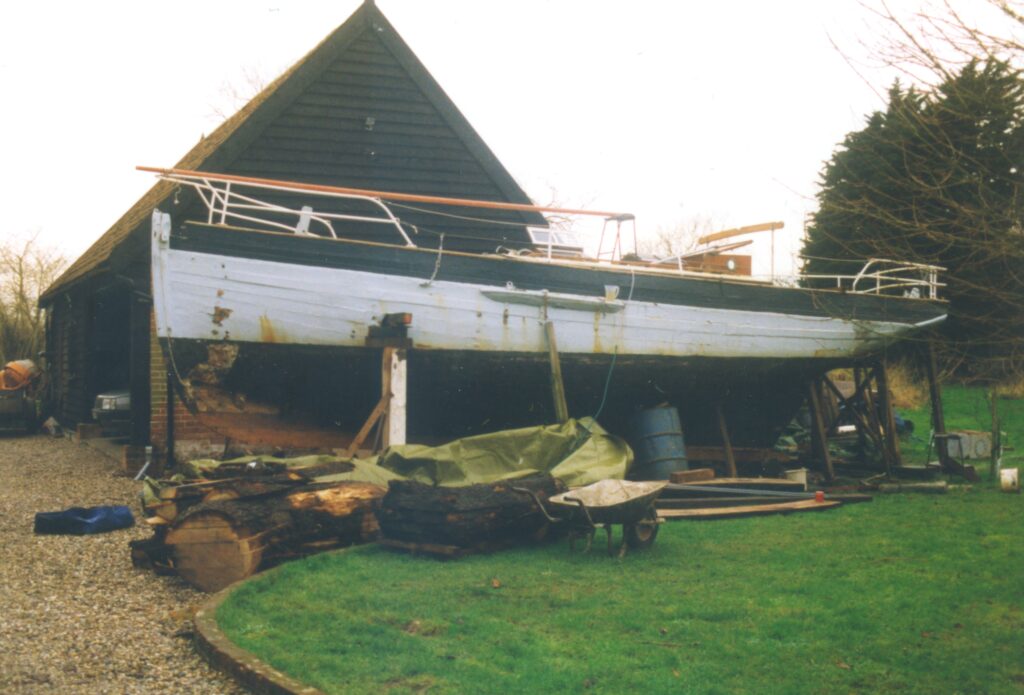
We had just completed the OGA East Coast OGA race in 1998 and starting our summer holiday. As we sailed away from St Lawrence, Stone towards the Bench Head I said ‘Let’s go South.’ We hadn’t made any plans for the summer, well Clare hadn’t, but I wanted to sail to Lymington to have another closer look at ‘Transcur’. So we set out through the Swin Spitway and across the Thames Estuary. It was a bit lumpy around the Edinburgh Channel and poor old ‘Margaret’ started to leak a bit. One of the plank butts was not as good as it should have been. Two days later we were on the quay in Lymington patching the seam with mastic putty and a lead tingle. Leak fixed. It was a bright day, little to no wind and we saw ‘Transcur’ heading down the river pushed by a dinghy strapped alongside. The elderly owners were onboard. The boat looked just the same, run down, neglected, looking for a new owner. We watched her sail past the ferry terminal, heading for the Solent. She didn’t really look much like a smack, tall Bermudan mast, short boom and bowsprit, long coachroof and cockpit. The once graceful counter had been sawn off with a bit of old ply making a sort of transom. You had to look at the boat in a special way to see past all the horrors, but underneath it all there was potential. We knew she was not going to be a fast smack but being built by Aldous we know she would sail well and she had good accommodation. When ‘Transcur’ returned to her mooring that afternoon we set off in our dinghy and had a closer look. Bluff in the bows, beamy, spacious, yes she would do. We contacted the owner again and a deal was struck. That was just the start.
In October 1998 I was still working full time when a message came through to me stating that Berthons Boatyard would not lift out ‘Transcur’ without a signed declaration that they would not be liable for any damage. They had the boat on the quayside but were worried about her strength for the lift. I quickly faxed through the signed declaration and she was out with mast removed. We had been given the name of a good transport company who would bring her to Suffolk. They used a massive trailer which usually moved the larger classes of lifeboats around the country. It was available at a fair price. At home we had a nice area of hardstanding which could be accessed through our neighbour’s drive. He had given us permission to use it so we could then get the boat into our garden. A week before the boat arrived our neighbour leant over the fence and said that I might need planning permission to put the boat in the garden. Alarm bells rang. I called the Council. They had already heard about the boat and wanted photos and details of what was going on. I suspected my neighbour . . . On Monday my neighbour knocked at the door. He said we couldn’t use his driveway after all. At 0700 Tuesday morning my neighbour parked his tractor across his driveway. We needed Plan B, the boat was about to arrive. Using our normal drive we put ‘Transcur’ alongside the garage. Access was very difficult and when the boat arrived the crane driver we’d booked said he couldn’t lift the boat as the reach was too far for the weight. After frantically calling nearly all the crane operators in Suffolk we found one that was just passing on his way back to the yard. The 60 ton crane moved into the drive, picked up ‘Transcur’ and swung her alongside the garage block with fantastic precision.
I had set out some keel blocks for ‘Transcur’ to sit on and plenty of prop for the bilges. As the crane lowered ‘Transcur’ onto the keel blocks the rest of the boat kept on going down. She was very weak. This was the first time we had seen her out of the water. I managed to position the boat so that we could easily build a simple frame over her to carry a heavy PVC tarpaulin fitted with a couple of large clear panels. The enormity of the task hit me as I cleared out all the accumulation of rubbish and dirt from years of neglect. I had already come across an article about the teredo worm illustrated with ‘Transcur’. I knew before we bought her that the keel would need to be replaced. A short survey down below indicated that most of her grown frames were seriously decayed along with deck beams and beamshelf. It was to be a total rebuild. Careful measurements were made to ensure we did not loose the shape. Clearly the sheer line had sagged over many years, especially at the stern where the last main beam attaches to the sternpost and fashion frames. There were no fastenings left and the ends of the beam had rotted away allowing the hull to move out and sag. Even though much of the counter had been cut off there was enough of the old structure to replicate the original full size.
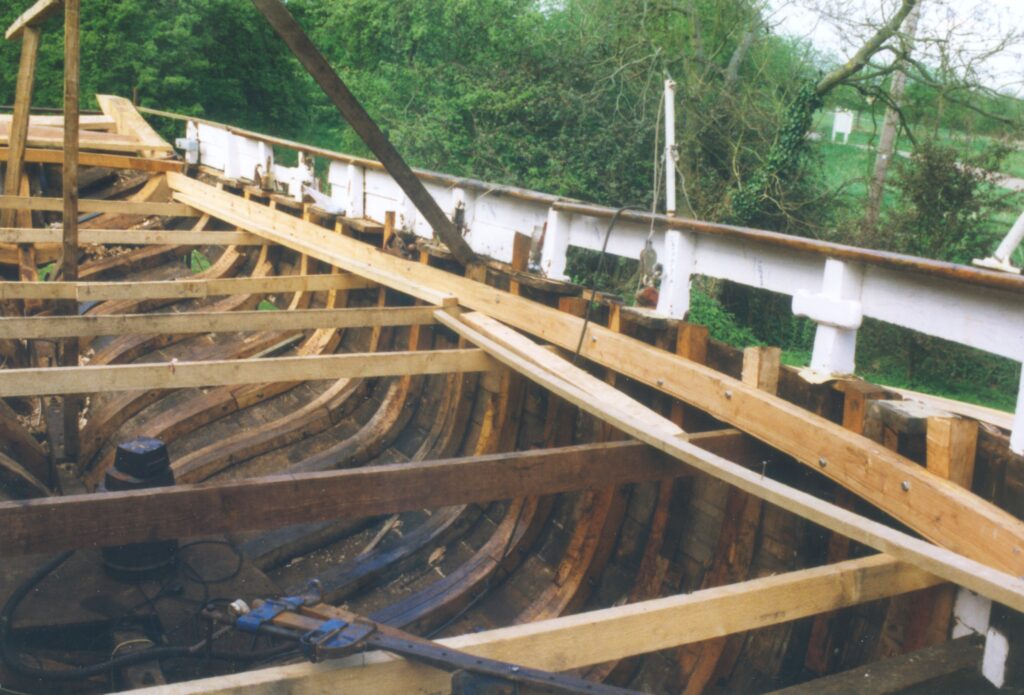
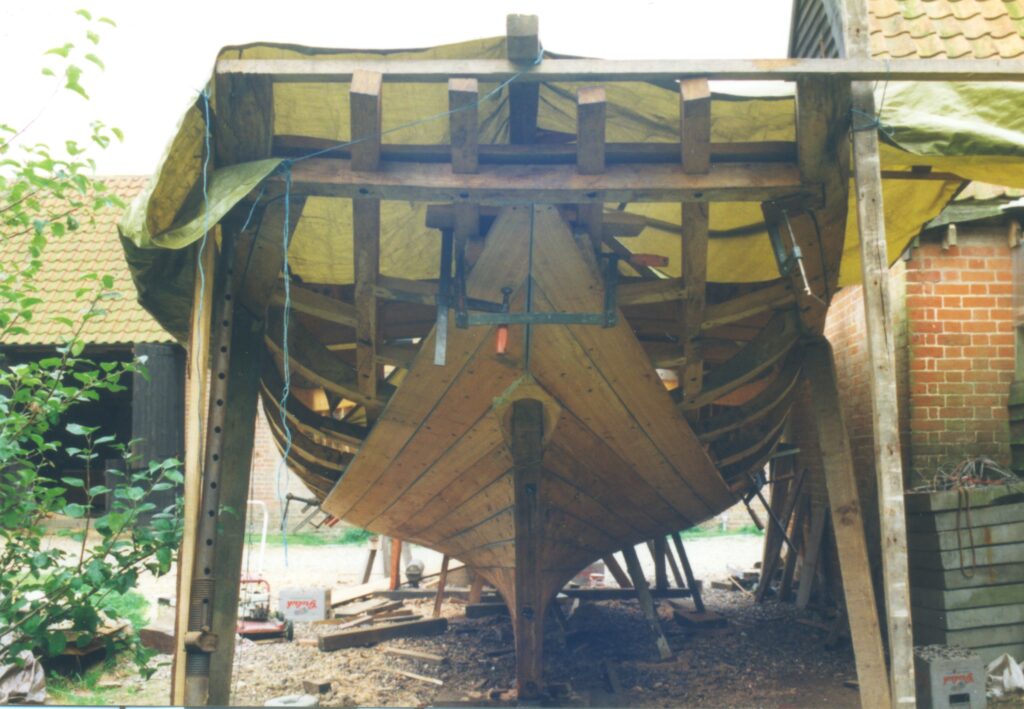
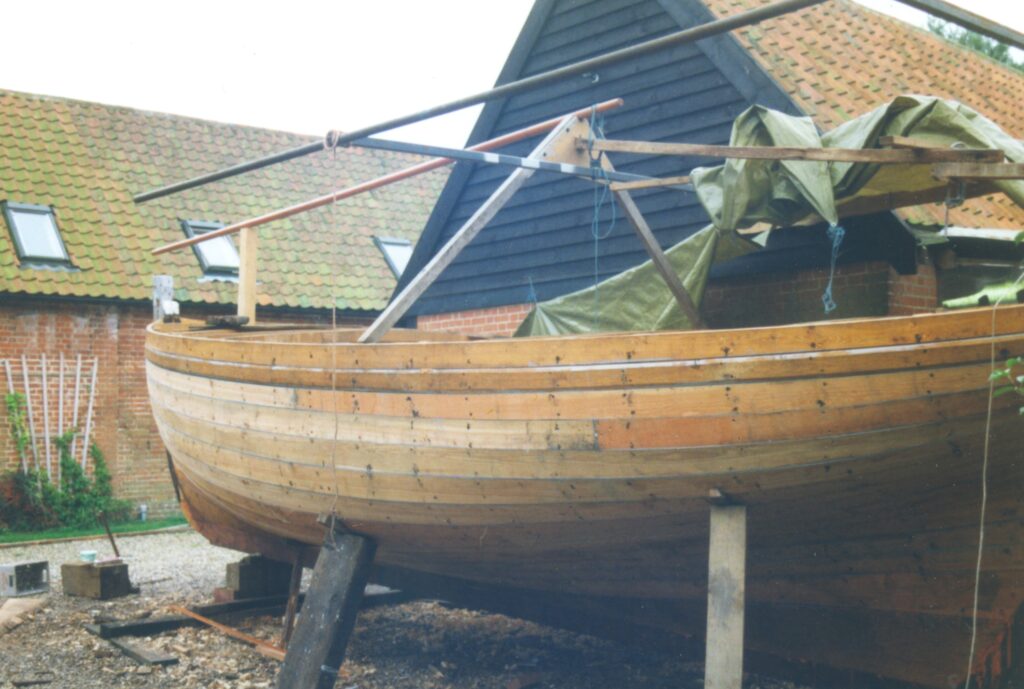
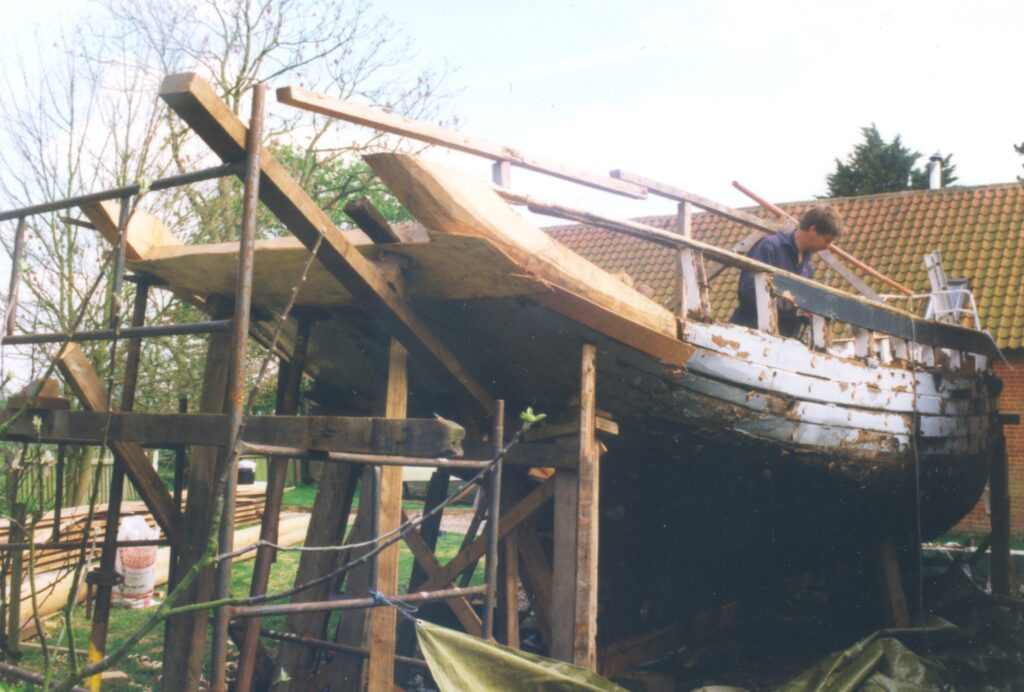
The keel was going to be the first part to be replaced. To do that required a lot of demolition. The keelson had to be removed, the old one was elm and in quite good condition but it was not going back. To extract the keel the garboard planks needed to come off and any keelbolts cut through. As is customary in Essex smacks the bottom of the boat and the space between the frames is concreted over. Very difficult to remove. Very pleasing was the fact that the frames and floors under the concrete were perfect. The oak floor timber was still white and very hard, like freshly sawn but only for a couple of minutes. It turned purple then black as the air got to it. There were no garboard fastenings left just black water in the space where the nails had been. The wood was sound. Only three keel bolts were found intact and severely wasted.
Dropping the old keel was a bit of a challenge, how to support her safely when not sitting on her keel. The solution was really quite simple. I constructed a cradle around the remains of the counter across the boat and attached some longitudonal timber to these and triangulated them to stop them rolling forwards or back. At the bow I cut a 150mm hole just forward of the mast each side under the sheer plank and passed a beam through the holes protruding 400mm each side. It was then quite easy to put a prop under each side to support the hull. Lots of packing and wedges and the weight was taken. A bit of fiddling and the old keel slid out. By mid December I had made a new keel from opepe, having removed the old one complete as a pattern. The old keel was riddled with teredo worm, around 10mm diameter holes. As work progressed the following year it was found that nearly all planks below the waterline had evidence of teredo worm.
Around a dozen large oak bends were bought, sawn and put in stick ready to make the new frames. Most had been felled for a couple of years. Between January and April most of the frames had been replaced. Larch sourced for the planking and oak for the deck beams, carlins and whale strake. I was very fortunate that only five miles away was one of the country,s biggest timber merchants at that time. They were invaluable in sourcing the long clear larch for planking and the oak for the whale strake and beams. By the end of July the boat was ready for planking. Having rebuilt the counter, archboard and fitted the new sheer strake and whale strake I decided that to move things on more quickly I would get a couple of skilled boatbuilders to complete the planking. I would work alongside them. Six weeks was the estimate for the job and it was done to the day superbly. We did stop for the eclipse in 2000, watching it through welding goggles. When Droid and Alan left at the end of the day I would go round and plug all the fastening holes and prepare what I could for the next day.
Words and photos: Pete Thomas

You must be logged in to post a comment.